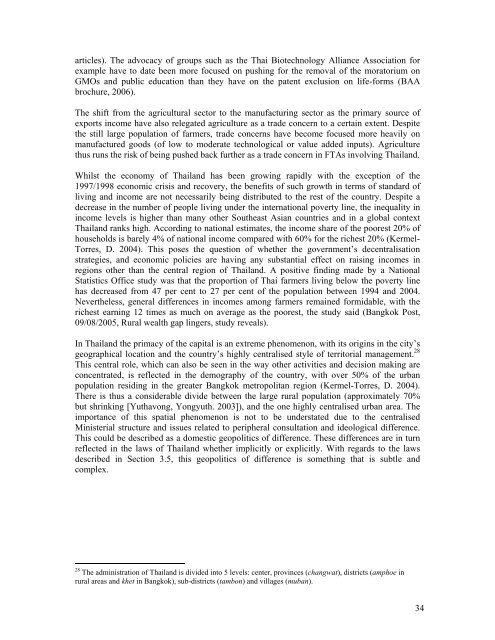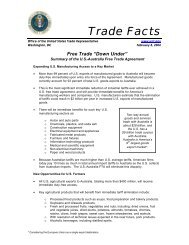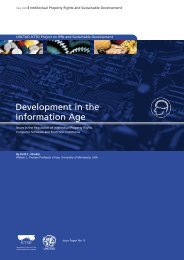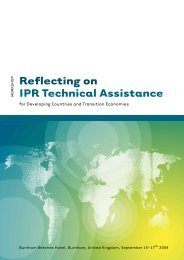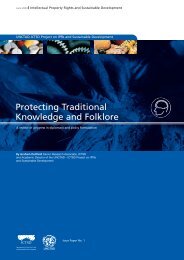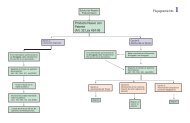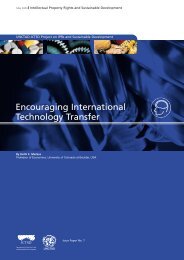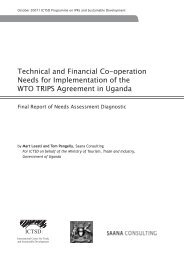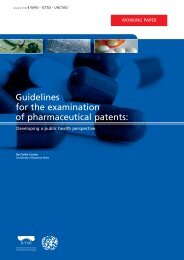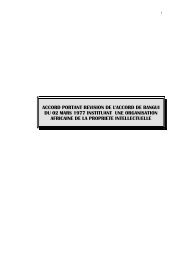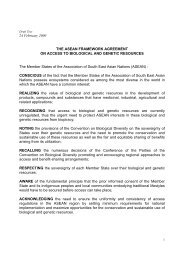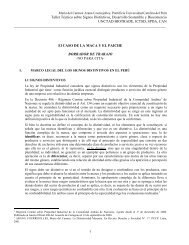Governance and Micropolitics of Traditional ... - IPRsonline.org
Governance and Micropolitics of Traditional ... - IPRsonline.org
Governance and Micropolitics of Traditional ... - IPRsonline.org
You also want an ePaper? Increase the reach of your titles
YUMPU automatically turns print PDFs into web optimized ePapers that Google loves.
articles). The advocacy <strong>of</strong> groups such as the Thai Biotechnology Alliance Association for<br />
example have to date been more focused on pushing for the removal <strong>of</strong> the moratorium on<br />
GMOs <strong>and</strong> public education than they have on the patent exclusion on life-forms (BAA<br />
brochure, 2006).<br />
The shift from the agricultural sector to the manufacturing sector as the primary source <strong>of</strong><br />
exports income have also relegated agriculture as a trade concern to a certain extent. Despite<br />
the still large population <strong>of</strong> farmers, trade concerns have become focused more heavily on<br />
manufactured goods (<strong>of</strong> low to moderate technological or value added inputs). Agriculture<br />
thus runs the risk <strong>of</strong> being pushed back further as a trade concern in FTAs involving Thail<strong>and</strong>.<br />
Whilst the economy <strong>of</strong> Thail<strong>and</strong> has been growing rapidly with the exception <strong>of</strong> the<br />
1997/1998 economic crisis <strong>and</strong> recovery, the benefits <strong>of</strong> such growth in terms <strong>of</strong> st<strong>and</strong>ard <strong>of</strong><br />
living <strong>and</strong> income are not necessarily being distributed to the rest <strong>of</strong> the country. Despite a<br />
decrease in the number <strong>of</strong> people living under the international poverty line, the inequality in<br />
income levels is higher than many other Southeast Asian countries <strong>and</strong> in a global context<br />
Thail<strong>and</strong> ranks high. According to national estimates, the income share <strong>of</strong> the poorest 20% <strong>of</strong><br />
households is barely 4% <strong>of</strong> national income compared with 60% for the richest 20% (Kermel-<br />
Torres, D. 2004). This poses the question <strong>of</strong> whether the government’s decentralisation<br />
strategies, <strong>and</strong> economic policies are having any substantial effect on raising incomes in<br />
regions other than the central region <strong>of</strong> Thail<strong>and</strong>. A positive finding made by a National<br />
Statistics Office study was that the proportion <strong>of</strong> Thai farmers living below the poverty line<br />
has decreased from 47 per cent to 27 per cent <strong>of</strong> the population between 1994 <strong>and</strong> 2004.<br />
Nevertheless, general differences in incomes among farmers remained formidable, with the<br />
richest earning 12 times as much on average as the poorest, the study said (Bangkok Post,<br />
09/08/2005, Rural wealth gap lingers, study reveals).<br />
In Thail<strong>and</strong> the primacy <strong>of</strong> the capital is an extreme phenomenon, with its origins in the city’s<br />
geographical location <strong>and</strong> the country’s highly centralised style <strong>of</strong> territorial management. 28<br />
This central role, which can also be seen in the way other activities <strong>and</strong> decision making are<br />
concentrated, is reflected in the demography <strong>of</strong> the country, with over 50% <strong>of</strong> the urban<br />
population residing in the greater Bangkok metropolitan region (Kermel-Torres, D. 2004).<br />
There is thus a considerable divide between the large rural population (approximately 70%<br />
but shrinking [Yuthavong, Yongyuth. 2003]), <strong>and</strong> the one highly centralised urban area. The<br />
importance <strong>of</strong> this spatial phenomenon is not to be understated due to the centralised<br />
Ministerial structure <strong>and</strong> issues related to peripheral consultation <strong>and</strong> ideological difference.<br />
This could be described as a domestic geopolitics <strong>of</strong> difference. These differences are in turn<br />
reflected in the laws <strong>of</strong> Thail<strong>and</strong> whether implicitly or explicitly. With regards to the laws<br />
described in Section 3.5, this geopolitics <strong>of</strong> difference is something that is subtle <strong>and</strong><br />
complex.<br />
28 The administration <strong>of</strong> Thail<strong>and</strong> is divided into 5 levels: center, provinces (changwat), districts (amphoe in<br />
rural areas <strong>and</strong> khet in Bangkok), sub-districts (tambon) <strong>and</strong> villages (muban).<br />
34


